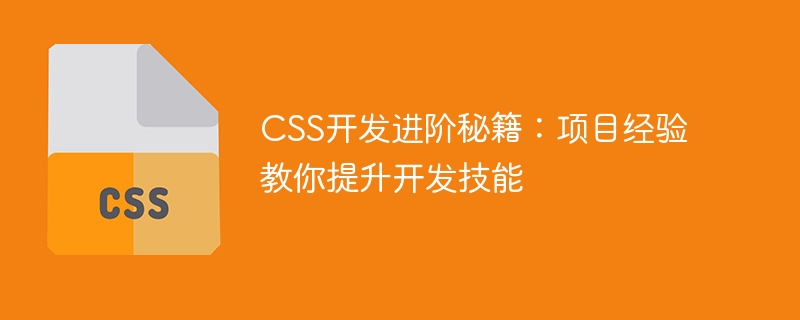

CSS development is an indispensable skill for front-end engineers. With the continuous development of front-end technology, CSS is also constantly updated and evolved. If you want to become an excellent CSS developer, in addition to mastering basic CSS syntax and properties, you also need to continuously improve your practical experience and skills.
This article will share some project experiences to help you further improve your CSS development skills.
1. Make full use of CSS preprocessor
CSS preprocessor can improve the maintainability and readability of CSS, and can also implement some functions that are not easy to implement in native CSS. Common CSS preprocessors include Sass and Less.
Using the CSS preprocessor allows you to use advanced features such as variables, nested rules, and mixed macros, which can help reduce duplicate code and improve code maintainability. In addition, the CSS preprocessor also supports modular development and can split CSS code into multiple files for easy organization and management.
2. Master CSS layout skills
CSS layout is an important content in CSS development. Mastering some common CSS layout techniques can help you realize various complex layout requirements more flexibly.
For example, Flexbox layout can be used to implement flexible box model layout, simplifying the traditional layout method. Grid layout allows you to more precisely control the position and size of elements. In addition, various complex layout effects can also be achieved using properties such as CSS positioning and floating.
3. Optimize CSS performance
CSS performance is crucial to the loading speed and user experience of web pages. Therefore, optimizing CSS performance is an aspect that cannot be ignored in CSS development.
First of all, you can reduce the file size by merging and compressing CSS files, thereby reducing network transmission time. In addition, CSS Sprite technology can be used to merge multiple small images into one large image to reduce the number of HTTP requests.
Secondly, pay attention to avoid using too many nestings and selectors, and try to keep the CSS code concise and readable. You can avoid selector conflicts and repeated definitions of styles by using naming conventions such as BEM.
Finally, use CSS animations and transition effects with caution. Transition effects cause additional draw and redraw operations, resulting in performance degradation. Therefore, when using CSS animations and transition effects, you must control the frame rate and rendering frequency of the animation to avoid frequent redrawing.
4. Cross-browser compatibility
Different browsers have different support and parsing of CSS. In order to ensure that web pages can be displayed and rendered correctly in different browsers, cross-browser compatibility testing and optimization are required.
You can use some CSS parsers and prefix auto-completion tools to solve compatibility issues. In addition, pay attention to follow standard CSS writing and syntax, and avoid using some special CSS properties and selectors to avoid compatibility issues.
5. Flexible use of CSS frameworks and libraries
CSS frameworks and libraries can quickly build the layout and style of web pages and improve development efficiency. Common CSS frameworks include Bootstrap and Foundation.
Using the CSS framework, you can implement responsive layout and common UI components by simply introducing and configuring them. By learning and using CSS frameworks, you can speed up development and reduce the amount of repetitive work.
However, be careful not to rely too much on CSS frameworks. You should choose appropriate frameworks and libraries based on the actual needs of the project, and also use customized CSS styles flexibly to achieve personalized needs.
6. Continuously learn and try
The world of CSS is changing with each passing day. With the introduction of new technologies and the emergence of new properties, the development methods of CSS are also constantly changing. As a CSS developer, you must constantly learn new CSS technologies and methods, and try new development methods.
You can communicate and share experiences with other developers by reading CSS-related documents and tutorials, participating in CSS-related communities and forums. In addition, you can also strengthen your professional knowledge and skills by participating in various front-end technology training and lectures.
To sum up, the key to improving CSS development skills is continuous practice and learning. Through the accumulation of project experience and the application of skills, you can continuously improve your development capabilities and become an excellent CSS developer. I believe that through unremitting efforts, you will be able to achieve greater achievements in the field of CSS development!
The above is the detailed content of Advanced tips for CSS development: Project experience teaches you to improve your development skills. For more information, please follow other related articles on the PHP Chinese website!




